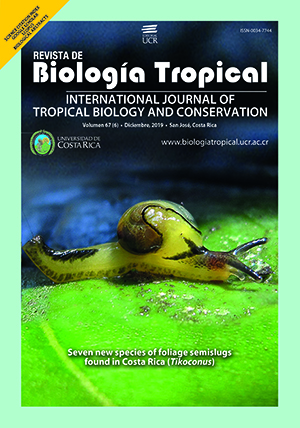Abstract
Introduction: The study of age and growth in fishes is a basic prerequiste to generate information on longevity, growth rates, population structure, among other attributes, all of them for the application of policies focused on the population management and conservation. We evaluated these attributes in the endangered Baja California killifish (Fundulus lima) that inhabits the oases of Baja California Sur, Mexico, with the perspective of generating base information for the conservation of this endemic fish. Objective: To determine the age, somatic growth and population structure of F. lima in one of the most important hydrological basins of its distribution range. Methods: From October 2002 to July 2004 we sampled for F. lima in 4 sites of La Purísima river by using passive and active collection methods. Individuals were measured and weighed in the field, where subsamples were selected for analysis of age based on scales. All the individuals were released alive to its original sites of capture. We assessed the age, length-weight and length-length relationships and population structure on the basis of 802 individuals examined by non-invasive techniques. Results: The somatic growth of F. lima was of positive allometric type (b> 3.0) in all the populations studied, with values of "b" ranging from 3.126 (Ojo de Agua) to 3.420 (El Pilón). Three age clases (0, 1 and 2 years old) were recognized, of which the age 1 year was the most frequent (49 %). The polimodal method based on length-frequency data also identified three age classes. Back-calculated total lengths at previous ages based in increments of growth in scales was 38.61 and 68.81 mm for individuals of 1 and 2 years, respectively. Conclusions: Three age classes (0, 1 and 2 year old) were determined for the populations of F. lima in the río La Purísima, based on the interpretation of annual growth rings in scales and in the modal distribution of observed length frequencies. All the populations examined showed a positive allometric growth (b> 3.0).en peces
##plugins.facebook.comentarios##

This work is licensed under a Creative Commons Attribution 4.0 International License.
Copyright (c) 2019 GORGONIO RUIZ-CAMPOS, Violeta Belinda Arista-Palacios, Asunción Andreu-Soler







